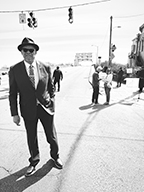A Message From The Publisher
24 In the Year of Jubilee the field will revert to the person from whom it was bought, the one
whose land it was Leviticus 27:24
By Bobby R. Henry, Sr.
Sixty years have passed since the brutal events of Bloody Sunday, when brave men and women risked everything to march across the Edmund Pettus Bridge in pursuit of justice. Their sacrifice shook the nation and paved the way for the Voting Rights Act of 1965. Yet, as I stood in Selma for the first time, I could not escape a sobering truth: we are still climbing the rough side of the mountain.
As I often say, “If this mountain were made of glass, no one could climb it”. The struggle itself, the rough spots, the jagged edges—gives us the grip we need to ascend. It provides moments of solitude in the struggle, places where we can pause, reflect, and gather our strength. These rough patches serve as lookout points, allowing us to see just how far we have come and, more importantly, to look higher, onward, and upward. Without these challenges, we would never truly appreciate the journey or understand the depth of our resilience.
Selma is not just a city; it reflects America’s deepest struggles. Violence still exists, poverty still cripples communities, and injustice still rears its head. Yet, amid the hardship, there is hope. There are people like the Jubilee co-founders Hank Sanders and Faya Rose Toure who dedicate their lives to preserving the true meaning of Bloody Sunday. They, and others like them, remind us that the fight for justice is far from over.
The need for mass meetings continues—not just in Selma, but across this nation. We need spaces where people can gather, organize, and push forward the ideals of freedom, justice, and equality—values built on the backs of diversity, equity, and inclusion. The fight for civil rights must not be a relic of history but a present-day movement that engages every generation.
Poverty still grips Selma. Unemployment remains painfully high, and the disparities in healthcare continue to cost lives. Even after the devastating tornado of 2023, too many buildings remain battered and broken, blue tarps replacing rooftops, abandoned structures standing as haunting reminders of neglect. These scars on the cityscape are not just remnants of natural disaster but of systemic disinvestment.
As thousands gather each year to commemorate the courage of those who marched, I wonder: how many will leave behind more than their footprints? Too often, the ceremonies become mere rituals, a yearly pilgrimage that stirs emotions but leaves little lasting change. Even some dignitaries, who should be leading the charge for progress, use this moment for a photo op rather than a call to action. And perhaps most disheartening of all, even after the blood shed on this soil, some citizens still do not vote.
Selma is more than a historical landmark; it is a living, breathing community with people who deserve investment, opportunity, and hope. If the bridge still stands, if the streets still echo with the cries of the past, then the fight for justice must still go on.
This was my first time in Selma, but I pray it will not be my last. More than that, I pray that my next visit will be one where I can contribute, whether by helping rebuild, supporting local businesses, or simply encouraging the sons and daughters of Selma to fight on. Because if the past 60 years have taught us anything, it is that change does not come from remembering alone. It comes from action.
When we rebuild Selma, we rebuild America. Selma’s struggle is America’s struggle. And the climb continues.
